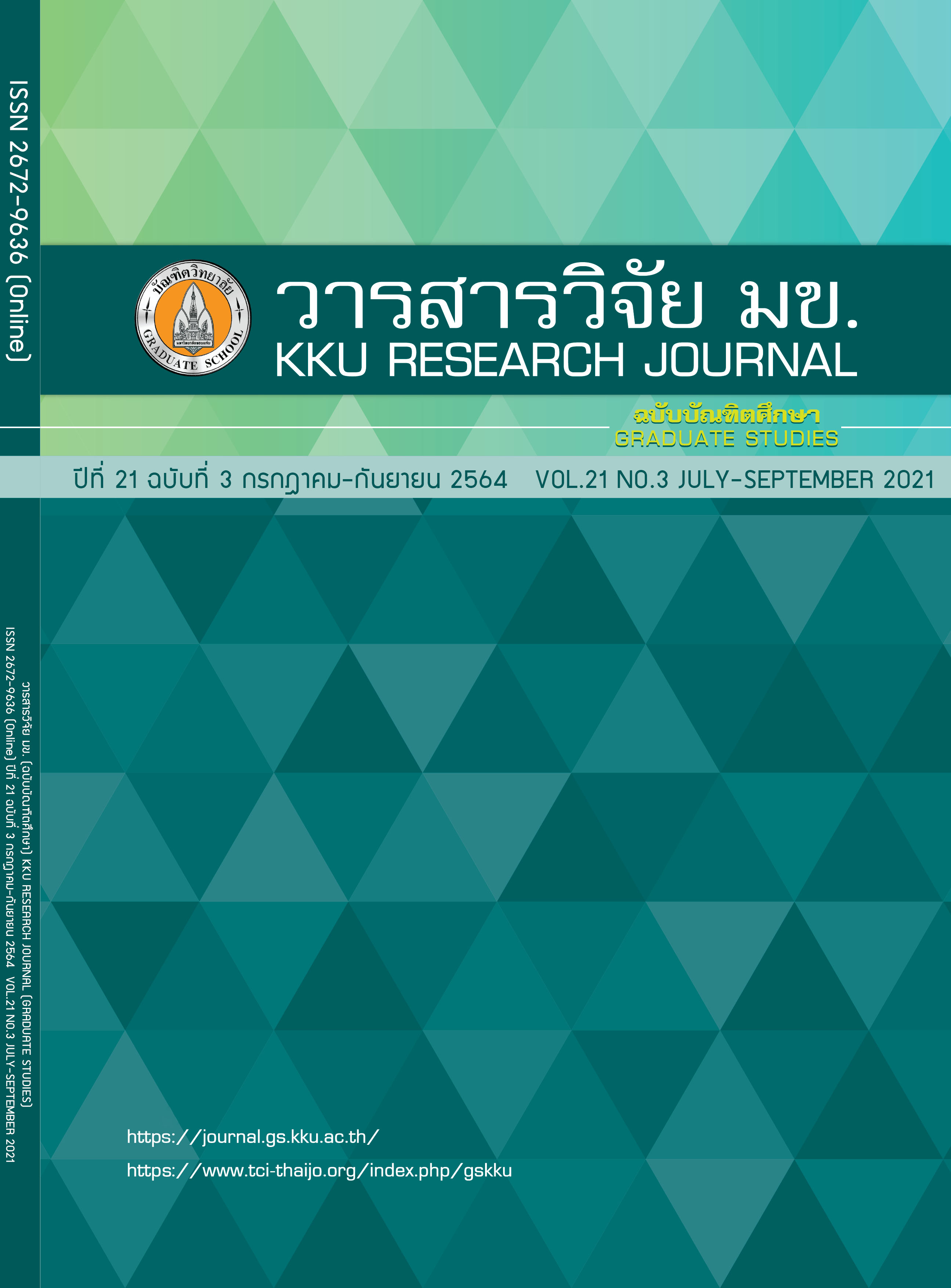The Study of the Prevalence of Cold-Related Symptoms and Factors Associated with Peripheral Circulation Symptoms Among Workers Work at 0-15°C
Keywords:
0-15°C, Goods distribution center, Food processing factory, Cold-related symptomsAbstract
This study aimed to investigate the prevalence of cold-related symptoms and factors associated with peripheral circulation symptoms among workers exposed to cold at 0-15°C workplace. Air temperature, relative humidity and wind speed were measured and the questionnaires were used to collect personal data, health behavior, work characteristic, workwear and cold-related symptoms. The participants comprised 80 workers in one distribution center and three food processing. The result revealed that the average air temperature, wind speed and relative humidity were: 5.60 (0.5-13.55)°C; 0.28 (33.5-77.3)m/s; and 51.16 (33.5-77.3)%, respectively. The highest prevalence of cold-related symptoms of the subjects included respiratory (70.0%), peripheral circulation (66.2%), finger symptoms episodic (62.5%) and musculoskeletal (62.5%), respectively. While employment period was only work factor exhibited a significant association with peripheral circulation symptoms (p=0.003) and personal factors were gender (p=0.048), age (p=0.017)
References
The Office of Industrial Economics. Industrial Economic Status Report for 2017 and Outlook for 2018 Ministry of industry; 2017. Thai.
Department of industrial works. Amount of cold industry in Thailand 2018 [Internet]. 2018 [updated 2018; cited 2018 March, 3 ]. Available from: http://www.diw.go.th.
McMeekin TA, Brown J, Krist K, Miles D, Neumeyer K, Nichols DS, et al. Quantitative microbiology: a basis for food safety. Emerging Infectious Diseases. 1997;3(4):541-549.
Koskela HO. Cold air-provoked respiratory symptoms: the mechanisms and management. International Journal of Circumpolar Health. 2007;66(2):91-100.
Näyhä S. Cold and the risk of cardiovascular diseases. International Journal of Circumpolar Health. 2002;61(4):373-80.
Barhum L. How do you improve poor circulation? [Internet]. 2018 [updated 4 July 2018; cited 2019 25 March]. Available from: https://www.medicalnewstoday.com/articles/322371.php.
International Standards Organization. ISO9920:2007 Ergonomics of the thermal environment — Estimation of thermal insulation and water vapour resistance of a clothing ensemble. Geneva2007.
Kaminski M, Bourgine M, Zins M, Touranchet A, Verger C. Risk factors for Raynaud's phenomenon among workers in poultry slaughterhouses and canning factories. International Journal of Epidemiology. 1997;26(2):371-380.
Lehmuskallio E, Hassi J, Kettunen P. The skin in the cold. International Journal of Circumpolar Health. 2002;61(3):277-286.
Casa DJ, Becker SM, Ganio MS, Brown CM, Yeargin SW, Roti MW, et al. Validity of Devices That Assess Body Temperature During Outdoor Exercise in the Heat. Journal of Athletic Training. 2007;42(3):333-342.
Castellani JW, Tipton MJ. Cold Stress Effects on Exposure Tolerance and Exercise Performance. Comprehensive Physiology. 2015;6(1):443-469.
Cheung SS. Responses of the hands and feet to cold exposure. Temperature (Austin). 2015;2(1):105-120.
Sampson S. What to know about poor circulation [Internet]. 2018 [cited 2019 October 18]. Available from: https://www.medicalnewstoday.com/articles/322371.php.
Chen WL, Shih YC, Chi CF. Hand and finger dexterity as a function of skin temperature, EMG, and ambient condition. Hum Factors. 2010;52(3):426-440.
Canadian Centre for Occupational Health and Safety. Cold Environments - Working in the Cold [Internet]. [updated April 8, 2019; cited 2019 May 22]. Available from: ttps://www.ccohs.ca/oshanswers/phys_agents/cold_working.html.
National Institute of Occupational Safety and Health. Cold Stress - Recommendations for Employers 2018 [updated June 6, 2018; cited 2019 May 22]. Available from: https://www.cdc.gov/niosh/topics/coldstress/recommendations.html.
United States Department of Labor. Occupational Safety and Health Administration-Cold Stress Guide [cited 2019 December, 20]. Available from: https://www.osha.gov/SLTC/emergencypreparedness/guides/cold.html.
Thetkathuek A, Yingratanasuk T, Jaidee W, Ekburanawat W. Cold exposure and health effects among frozen food processing workers in eastern Thailand. Safety and Health at Work. 2015;6(1):56-61.
Påsche A. Occupational health in the fish processing industry-An activity to improve the work environment by preventing cold exposure. 2001.
Cochran WG. Sampling Techniques. 3rd, Edition by John Wiley and Sons Inc., New York. 1977.
Chotiphan C, Auttanate N, Maruo SJ, NÄyhÄ S, Jussila K, Rissanen S, et al. Prevalence of cold-related symptoms among Thai chicken meat industry workers: association with workplace temperature and thermal insulation of clothing. Industrial Health. 2020.
The National Public Health Institute of Finland. National Health Survey Finrisk-Cold and Heat Inquiry; 2007.
International Standards Organization. ISO15743:2008. Ergonomics of the thermal environment-Cold workplaces-Risk assessment and Management. Geneva2008.
Parkinson T, Dear RD. Thermal pleasure in built environments: spatial alliesthesia from air movement. Building Research & Information. 2016;43(3):1-16.
Pienimäki T. Cold exposure and musculoskeletal disorders and diseases. A review. International Journal of Circumpolar Health. 2002;61(2):173-182.
International Standards Organization. Ergonomics of the thermal environment-Determination and interpretation of cold stress when using required clothing(IREQ) and local cooling effect. ISO 11079:2007. p. 21-33.
Arundel AV, Sterling EM, Biggin JH, Sterling TD. Indirect health effects of relative humidity in indoor environments. Environmental Health Perspectives. 1986;65:351-361.
Koskela H, Pihlajamaki J, Pekkarinen H, Tukiainen H. Effect of cold air on exercise capacity in COPD: increase or decrease. 1998;113(6):1560-1565.
Wilson O, Goldman RF. Role of air temperature and wind in the time necessary for a finger to freeze. Journal of Applied Physiology. 1970;29(5):658-664.
McArdle WD, Magel JR, Gergley TJ, Spina RJ, Toner MM. Thermal adjustment to cold-water exposure in resting men and women. Journal of Applied Physiology. 1984;56(6):1565-1571.
Kenney WL, Armstrong CG. Reflex peripheral vasoconstriction is diminished in older men. Journal of Applied Physiology. 1996;80(2):512-515.



